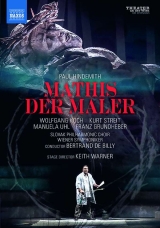Die 1938 in Zürich uraufgeführte Oper Mathis der Maler von Paul Hindemith behandelt in sieben Bildern Episoden aus dem Leben des Malers Matthias Grünewald (gelegentlich auch als Mathis Nithart bezeichnet). Der Schöpfer des Isenheimer Altars wird in der Oper mit der Reformation und mit den Bauernkriegen in Verbindung gebracht, was den Hauptstrang der Handlung ausmacht und das Drama schürt.
Naxos veröffentlicht die erste offizielle Videoproduktion der Oper. Sie stammt aus dem Jahre 2012, wurde am Theater an der Wien gemacht und ist von größter Bedeutung für die Verbreitung dieser allzu wenig bekannten Oper. Obschon ich niemandem raten kann, auf das so beeindruckende Bild zu verzichten: es gibt die Musik dieser Produktion auch als CD bei Capriccio (C5450).
Ein Merkmal der Inszenierung ist die Präsenz des Gekreuzigten aus Grünewalds Isenheimer Altar als überdimensionale Skulptur in diversen Formen bez. auch nur Teilen davon, wie z.B. der Dornenkrone.
In diesem suggestiven Bühnenbild sorgt Keith Warner für eine prächtige Inszenierung, die das Drama maximal auslotet und die gut dreistündige Oper zu einem packenden und nachhaltigen visuellen Erlebnis werden lässt.
Die Titelrolle ist mit dem Bariton Wolfgang Koch sehr gut besetzt. Er überzeugt mit einer flexiblen, gut geführten und ausdrucksstarken Stimme. In seiner Darstellung kommt die aufgeschlossene Haltung des Malers in Sachen Religion und Politik im Zusammenhang mit der Kunst, gut zur Wirkung und zeigt beeindruckend, was Hindemith eigentlich aussagen will: nämlich, dass der Künstler im wie auch immer gearteten, ggf. konfliktreichen politischen und sozialen Umfeld vor allem seiner Kunst und seinem Talent treu bleiben soll. Das war in der Mitte der Dreissigerjahre des 20. Jahrhunderts im Nazi-Deutschland ein wichtiges Thema, das dann auch prompt zum Verbot der Oper führte.
Stimmlich und darstellerisch überzeugend singen und agieren der Tenor Raymond Very als Hans Schwalb, Führer der Bauern, und die einfühlsam singende Sopranistin Katerina Tretyakova als seine Tochter Regina.
Nicht weniger gut gefallen der stimmkräftige Bariton Franz Grundheber als reicher Protestant Riedinger und (mit Einschränkungen wegen einiger Schwächen im oberen Register) Kurt Streit in der Rolle von Riedingers Gegenspieler Albrecht von Brandenburg, dem Kardinal Erzbischof von Mainz, der von Luther aufgerufen wird zum Protestantismus zu wechseln, was zur Heirat mit Riedingers Tochter führen sollte . Doch der Kardinal widersteht der Versuchung.
Die Nebenrollen sind alle mehr oder weniger gut besetzt. Auch der Slowakische Philharmonische Chor ist exzellent, genau wie das Orchester der Wiener Symphoniker, die unter der inspirierten und dynamischen Leitung von Bertrand de Billy ihr hohes Niveau unter Beweis stellen.
Ton- und die Bildqualität der Aufnahme aus dem Jahr 2012 sind ausgezeichnet.
The opera Mathis der Maler by Paul Hindemith, which premiered in Zurich in 1938, deals in seven pictures with episodes from the life of the painter Matthias Grünewald (sometimes also referred to as Mathis Nithart). In the opera, the creator of the Isenheim Altarpiece is associated with the Reformation and with the Peasants’ Wars, which is the main topic of the plot and fuels the drama.
Naxos is releasing the first official video production of the opera. It dates from 2012, was made at the Theater an der Wien, and is of the utmost importance for the promotion of this all-too-little-known opera. Although I can’t advise anyone to miss out on such an impressive film: the music alone from this production is available on CD from Capriccio (C5450).
One feature of the production is the presence of the Crucified from Grünewald’s Isenheim Altarpiece as an oversized sculpture in various forms, or only parts of it, such as the crown of thorns.
In this suggestive stage setting, Keith Warner provides a splendid staging that explores the drama to the maximum and turns the opera, which lasts a good three hours, into a gripping and lasting visual experience.
The title role is very well cast with baritone Wolfgang Koch. He convinces with a flexible, well-managed and expressive voice. In his portrayal, the open-minded attitude of the painter in matters of religion and politics in connection with art, comes across well and impressively shows what Hindemith actually wants to say: namely, that the artist in whatever political and social environment, possibly full of conflict, should above all remain true to his art and his talent. This was an important theme in Nazi Germany in the mid-thirties of the 20th century, which then promptly led to the banning of opera.
Tenor Raymond Very as Hans Schwalb, leader of the peasants, and the sensitively singing soprano Katerina Tretyakova as his daughter Regina are singing and acting convincingly.
No less pleasing are the strong-voiced baritone Franz Grundheber as the wealthy Protestant Riedinger and (with reservations because of some weaknesses in the upper register) Kurt Streit in the role of Riedinger’s adversary Albrecht von Brandenburg, the Cardinal Archbishop of Mainz, who is called upon by Luther to convert to Protestantism, which should lead to marriage with Riedinger’s daughter. But the cardinal resists the temptation.
The supporting roles are all more or less well cast. The Slovak Philharmonic Choir is also excellent, as is the Vienna Symphony Orchestra, which demonstrates its high level under the inspired and dynamic direction of Bertrand de Billy.
Sound and picture quality of the 2012 recording are excellent.






















